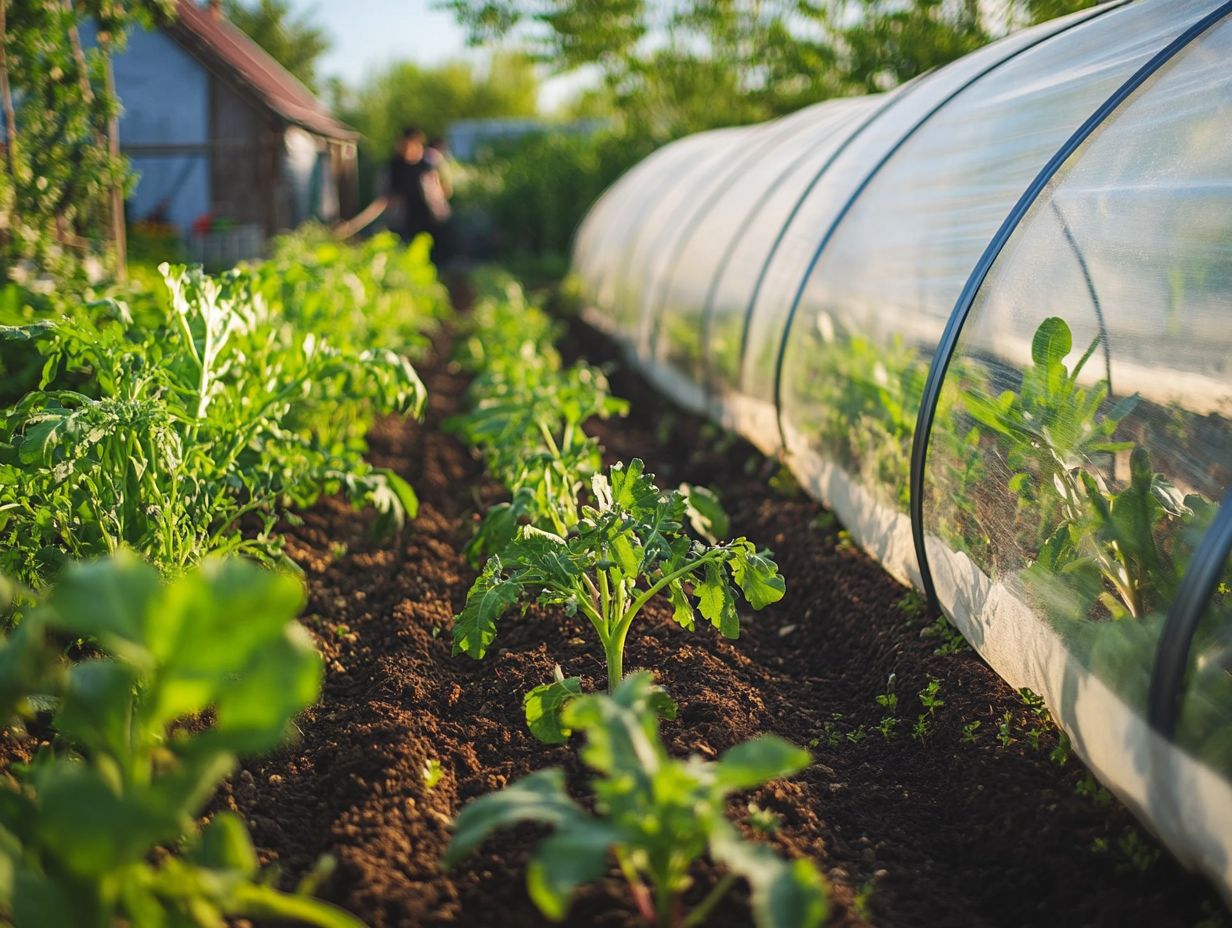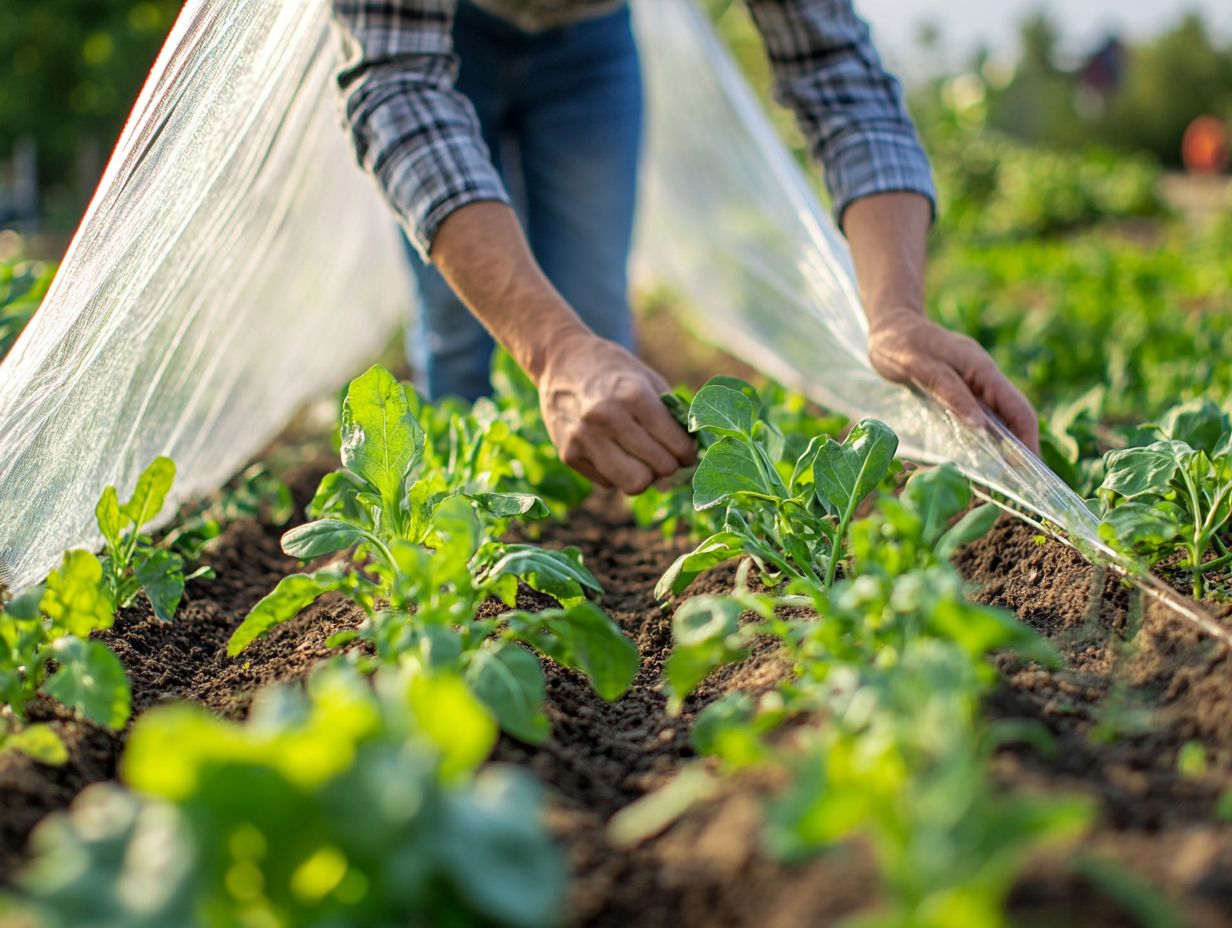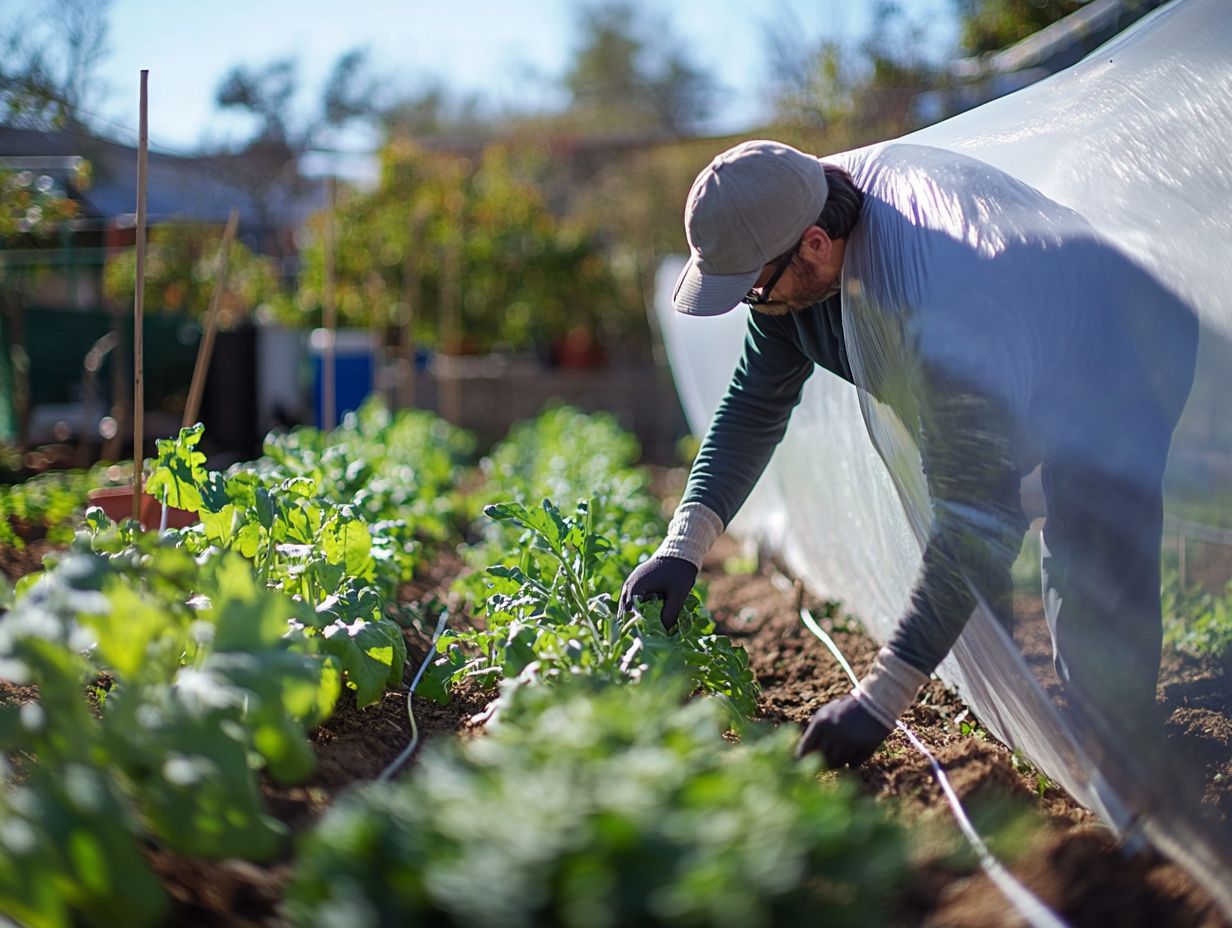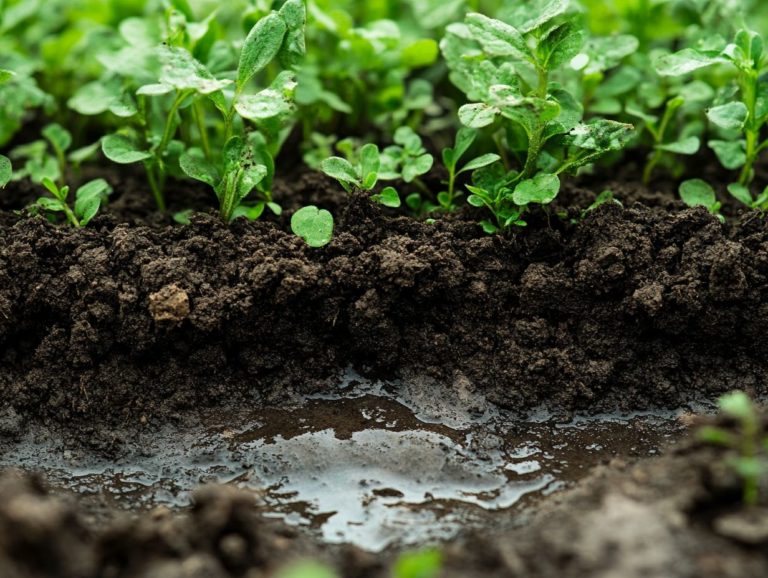How to Use Row Covers Effectively?
Row covers are an exceptionally versatile gardening tool that can elevate your growing experience to new heights. Whether you re protecting your plants from pests or shielding them from extreme weather, these lightweight barriers offer many benefits.
This discussion delves into the various types of row covers, including floating and mesh options, and reveals how to use them effectively for optimal plant growth. From selecting the ideal cover to installation and maintenance tips, you ll discover how to enhance your gardening prowess and secure a bountiful harvest.
Contents
Key Takeaways:

- Choosing the right type of row cover is crucial for effective use. Consider factors such as plant type, climate, and potential pests before deciding.
- Proper installation and maintenance techniques are key for maximizing the benefits of row covers. Regularly check for tears or damage and make necessary repairs.
- Row covers can be even more effective when combined with other gardening techniques, such as crop rotation or companion planting. Experiment to find the best combination for your plants.
What are Row Covers?
Row covers, particularly the DIY winter variety, offer an ingenious way to safeguard your fall garden against the harshness of winter weather. These versatile gardening tools are crafted from lightweight, breathable materials like polypropylene and polyester, providing insulation that enhances plant growth.
They serve a dual purpose: offering frost protection and helping you manage pests without chemicals, making them a critical asset for anyone looking to extend their growing season and keep crops healthy throughout the colder months.
Drape row covers easily over your crops, creating a microclimate a special environment for plants that shields delicate seedlings from frigid temperatures while simultaneously warding off pests like aphids. Horticultural fabric also acts as a protective barrier, reducing the risk of disease while still allowing sunlight and moisture to seep through, promoting vibrant growth.
The advantages stretch well beyond immediate protection. Row covers help maintain soil temperature, ensuring that your tender perennials flourish even when frost threatens their existence. By embracing these organic methods, you can cultivate a thriving, chemical-free garden that continues to thrive even in the face of challenging conditions.
Benefits of Using Row Covers
Utilizing row covers brings a host of benefits that can elevate your gardening experience, especially during the winter months. These covers act as effective shields, safeguarding your fall garden from frost, pests, and various harsh weather conditions.
This protection not only fosters healthier plant growth but also contributes to extending your growing season. By incorporating straightforward solutions like DIY winter row covers, you can secure better yields and cultivate robust plants while embracing chemical-free pest management.
Protection from Pests and Weather
Row covers are your plants’ best friends, offering essential protection from pesky pests and the harshness of winter weather. They ensure that your plants thrive even in challenging conditions.
Acting as a reliable barrier against insects while providing frost protection, these innovative tools help shield your young seedlings and seasonal crops from the elements. With row covers in place, you can enjoy the peace of mind that comes from knowing your plants are safe and sound, all while promoting chemical-free pest protection.
These protective coverings serve as your first line of defense against common garden threats like aphids, caterpillars, and beetles that can wreak havoc on fragile crops. They also prevent damage from those unexpected frosts, particularly in early spring when temperatures can drop dramatically overnight, putting sensitive plants at risk.
When utilized effectively, fabric or mesh traps warmth while still allowing sunlight and moisture to seep through, creating an optimal microclimate. This dual action not only keeps pests at bay but also minimizes the risks posed by extreme temperature fluctuations, leading to healthier, more robust harvests.
Start using row covers today and watch your garden flourish!
Improved Plant Growth
Row covers can significantly enhance your plant growth by creating an optimal microclimate that nurtures young seedlings and seasonal crops. These protective layers insulate your plants from chilling temperatures while allowing you to monitor moisture levels. This ensures a healthy growing environment.
Maintaining an ideal soil temperature beneath the covers contributes to accelerated plant development and improved resilience.
You ll find various types of row covers, such as floating row covers and hoop houses, each with unique advantages. Floating row covers trap heat, fostering a warmer environment that can extend your growing season especially beneficial in early spring or late fall.
On the flip side, hoop houses provide sturdier structures that offer substantial protection from harsh weather and pests. They allow you to control humidity and temperature more effectively. This control accelerates germination and encourages robust root development, leading to healthier, more productive plants.
Types of Row Covers

You have several types of row covers at your disposal. Each is crafted to cater to specific gardening needs and elevate your season extension efforts.
Floating row covers, mesh row covers, and hoop houses present varying degrees of protection and functionality. They enable you to shield your plants from harsh weather conditions and pesky pests.
Explore these options to find the perfect cover for your crops. This ensures they thrive optimally throughout the seasons.
Floating Row Covers
Floating row covers stand out as one of the most popular options for gardeners like you. Their lightweight, breathable fabric allows air and moisture to flow freely while providing exceptional frost protection.
These versatile coverings are perfect for keeping your plants warm during cold weather and can effectively manage pest populations without resorting to chemicals, making them a go-to choice for organic gardening enthusiasts.
Made from spun polypropylene or polyester, these fabrics are designed to keep harmful insects at bay while still letting sunlight nourish your plants. Floating row covers are particularly advantageous for seedlings and delicate vegetables such as tomatoes and peppers, as they create a microclimate that encourages growth, even when temperatures dip.
They act as a protective barrier against common pests like aphids and caterpillars, ensuring that your plants remain healthy throughout the growing season. By incorporating floating row covers into your gardening practices, you can strengthen your crops against environmental challenges and enhance your yields.
Mesh Row Covers
Mesh row covers act as breathable, lightweight barriers that let sunlight and air flow freely while providing effective pest management solutions. They re designed to protect your plants from insects without obstructing essential nutrients, making them perfect for maintaining vibrant plant growth throughout the season.
By keeping your crops safe from harmful pests, you can reduce your reliance on chemical pesticides and embrace a more organic approach to gardening. These mesh coverings also shield delicate seedlings and established plants while helping regulate temperature, creating a microclimate that boosts growth rates.
Easily adaptable to various types of crops, they are a versatile addition to any gardener’s toolkit. Whether you re nurturing vegetables, fruits, or ornamental plants, using mesh row covers can significantly enhance your crop yield while minimizing your environmental impact.
Hoop Houses
Hoop houses, also known as high tunnels, are fantastic structures that keep plants warm and protected. They allow you, as a gardener, to extend the growing season for your crops significantly. Made from materials like fiberglass rods and covered in special plant fabric, these structures provide excellent frost protection while creating a controlled environment perfect for growing various plants year-round.
Whether you re planting in early spring or late fall, these versatile enclosures enable you to grow an impressive array of vegetables and herbs think tomatoes, cucumbers, and basil even during the chilly months. Hoop houses shield delicate plants from harsh temperatures and maximize sunlight exposure, promoting healthier growth.
They can be customized to suit various farming styles, making them a favorite among both small-scale and commercial growers. This adaptability allows you to nurture your crops under optimal conditions, leading to increased yields and superior quality produce.
How to Use Row Covers Effectively
To truly harness the benefits of row covers, you must understand how to use row covers for frost protection effectively. This involves mastering proper installation techniques to keep your DIY winter row covers securely in place. You should also apply maintenance and care tips to enhance their longevity and effectiveness in safeguarding your crops.
By following these guidelines, you can cultivate a thriving garden environment that nurtures plant growth and health!
Choosing the Right Cover for Your Plants

Choosing the right cover for your plants is crucial for their success! Consider the specific needs of tender perennials and the garden supplies you have on hand. Be sure to secure the edges tightly to prevent wind damage and maintain stability.
When evaluating your plants’ needs, think about their growth stages, the local climate, and potential pest threats. For instance, young seedlings thrive under lightweight row covers that provide warmth while allowing sunlight and moisture to nurture their development. In contrast, fruiting plants like tomatoes need sturdier protection against frosty nights and pesky insects.
By carefully considering these factors, you can choose the most suitable covers, such as spun polyester or floating row covers, that will enhance both plant health and yield.
Proper Installation Techniques
Proper installation techniques are vital for ensuring that your row covers remain effective throughout their usage period. Weigh them down with materials like rocks, bricks, or soil to prevent the wind from lifting them. Place them strategically to monitor moisture levels in your garden.
Using stakes or hoops provides extra support, creating a stable structure that allows for air circulation while shielding your plants from harsh weather. Consider the material of the covers; lightweight floating row covers are ideal for frost protection, while heavier options offer needed shade during hotter months.
Make sure the edges of the covers are tightly secured to keep pests out and maintain an optimal microclimate for your plants. Regularly check for signs of wear or damage to extend the longevity and efficiency of your row covers. Don t wait secure your covers to protect your plants now!
Maintenance and Care Tips
Maintenance and care tips are crucial for prolonging the life and effectiveness of your row covers, ensuring they continue to support your efforts in season extension and effective pest control. By regularly monitoring moisture levels and reusing your garden covers, you can significantly enhance your gardening experience while protecting your plants.
To fully optimize these benefits, you should routinely inspect your row covers for any signs of wear or tear. Even the smallest holes can compromise their effectiveness. Cleaning the covers after each season is essential. A gentle wash with mild soap removes lingering pests and diseases from the fabric.
Storing them in a cool, dry place prevents mildew and extends their lifespan. This ensures they’re ready for action when the next gardening season rolls around. Stick to these best practices, and your row covers will be your best allies against pests and bad weather!
Maximizing the Benefits of Row Covers
To truly maximize the benefits of row covers, it’s crucial to blend them seamlessly right away with other gardening techniques. For more insights, learn how to use row covers for winter crops. This creates a harmonious growing environment that allows you to protect plants effectively.
By incorporating DIY winter row covers alongside effective strategies for keeping pests away and frost protection, you can elevate your entire garden. This ensures your plants thrive healthily throughout the seasons.
Combining with Other Gardening Techniques
Combining row covers with other gardening techniques can greatly enhance the protection of your crops and improve overall harvest accessibility. Consider using row covers for winter protection alongside organic pesticides or employing shade netting during the hottest months. This creates a comprehensive protective strategy that promotes healthy plant growth.
For instance, integrating companion planting with row covers can yield impressive results. By growing pest-repellent flowers like marigolds near your covered crops, you can naturally deter harmful insects.
Incorporating drip irrigation beneath the row covers helps maintain consistent soil moisture. This method delivers water directly to the roots, minimizing plant stress.
This synergy allows your crops to thrive without competing for resources. Alternating between row covers and mulch can also optimize soil temperature, enhancing root development, especially when using floating row cover materials.
When you implement these combined methods thoughtfully, you not only safeguard your plants from environmental challenges but also maximize yields. This leads to a more bountiful harvest overall, particularly for your vegetable crops.
Frequently Asked Questions

Got questions about row covers? You’re not alone! Here are some common inquiries.
What are row covers and how can they be used effectively?
Row covers are lightweight, fabric or plastic covers that are placed over plants to protect them from pests, harsh weather conditions, and other environmental factors. They can be used effectively by covering plants at the right time and removing them when necessary.
When should I use row covers?
Row covers should be used when plants are young and vulnerable to pests, frost, or extreme temperatures. They should also be used during the growing season to protect plants from insects and other pests.
How do I secure row covers over my plants?
Row covers can be secured by placing weights on the edges of the covers, using stakes or hoops to create a frame, or by burying the edges of the covers in the soil. Make sure the covers are secure but not too tight to allow for plant growth.
Do I need to remove row covers to water my plants?
Yes, row covers should be removed to water plants. This ensures that the water reaches the plants and does not collect on top of the cover, potentially causing damage or creating a breeding ground for pests.
Can I reuse row covers?
Yes, row covers can be reused multiple times if they are still in good condition. Make sure to clean and store them properly after use to prevent any contamination or damage.
Are there any plants that do not benefit from row covers?
Some plants, such as those that rely on pollination, may not benefit from row covers as they can prevent insects from reaching the plants. It is important to research which plants are suitable for row covers before use.






